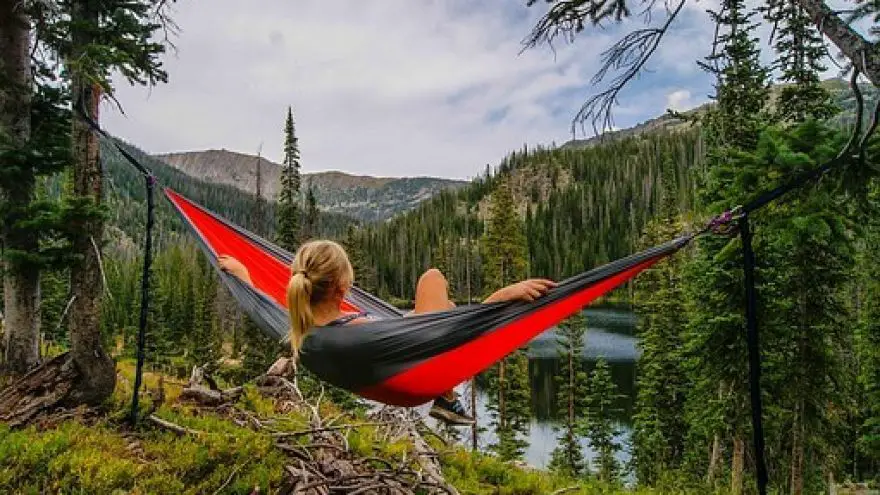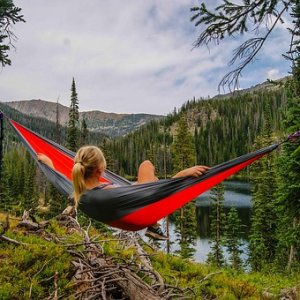The Ins and Outs of Sleeping in a Hammock in the Outdoors
 The Ins and Outs of Sleeping in a Hammock in the Outdoors
gearweare.net
The Ins and Outs of Sleeping in a Hammock in the Outdoors
gearweare.net
Getting into the outdoors can help replenish the soul. The quiet, the grand vistas, and the fresh air combine create an experience which photos and retellings struggle to capture. Those who truly relish getting into nature may want to amplify the sensations of being in the outdoors by sleeping under the stars, and a hammock is the easiest and most comfortable way to do this.
Although the idea of sleeping in a hammock typically conjures images of a white sandy beach and the hammock slung between two palm trees, hammock camping is really possible in a variety of conditions. The only true requisites are trees or other structures between which the hammock can be strung. Two cars can work just as well as trees, and may actually work better in areas like the desert, where trees tend to be low to the ground and scraggly. Other conditions, such as how cold it is at night and if it is going to rain, need to be accounted for, but with the right additional gear and know-how, hammocks can be a great way to sleep in the outdoors all year long.
Table of Contents
Hanging a Hammock
One common mistake that people make when hanging a hammock is that they make it too taught. The thought process is that a tighter hammock will lay flatter, however, the reality is that a too tight hammock will constrict one’s body and the fabric. This experience is both less comfortable and provides less usable space in the hammock that if it is hung with the proper amount of slack. The right amount of slack resembles a smile.
It is also important to not have too much slack. Too much slack can cause the sleeper to slouch towards the center of the hammock, pushing them into a ball as they sleep. When hanging a hammock, look for live trees that are at least a foot and a half in diameter. Dead trees can break and thinner trees can bend when weighted. The healthier and thicker the tree the better. Also, make sure to sling your hammock with webbing. Ropes can cut into trees, harming them, however, webbing distributes the pressure more evenly and is much better for the tree.

Proper Sleeping Position
A lot of people who believe hammocks can be harmful to sleep in are simply sleeping in them wrong. The proper way to sleep in a hammock is at an angle, about 30° off from the center, although the exact angle of comfort is different for everyone. Sleeping this way flattens the hammock naturally, allowing the back to take on its natural curve with the head and feet slightly elevated. At an angle, one is even able to sleep comfortably in a hammock on their side or stomach.

Staying Warm
A sleeping back is necessary when sleeping in a hammock in all but the warmest climates, but even a bag won’t be sufficient for warmth when the temperature starts to drop in the 50s and 40s °F during the night. A sleeping pad is also necessary as a way to insulate the bottom of the hammock. This is because compressed air can’t hold warmth, so even though a sleeping bag insulates the top of the hammock, it can’t insulate the areas that are flattened between the sleeper and the hammock. A sleeping pad creates space between the sleeping bag and the hammock which traps warm air.
One issue with sleeping pads in hammocks is that pads often shift during the night so that the sleeping is no longer on top or being warmed by the pad. Some hammocks come with a slot that a pad can be inserted into which solves this issue. Placing a sleeping pad inside one’s sleeping bag also solves this problem, although this only works if the bag is large enough. In super cold conditions, a sleeping pad may not be enough to keep your hammock warm. In these circumstances, an under- quilt will greatly increase the warmth of the hammock. Under quilts are insulating layers that are hung beneath the hammock. There should be space between the under quilt and the hammock so that a pocket of warm air is created between the two layers. For even greater warmth, a top quilt can be rigged above the hammock for what is essentially a sleeping bag for the whole setup.
Rain Flies
Even though hammocks don’t have roofs, they can be fully protected from the rain with a properly rigged rain fly. Although standard tarps will work fine for protecting a hammock, rains flies specifically designed to be used with these sleeping arrangements offer a few advantages. For one, they may come in shapes that are specifically designed to ensure that a hammock stays protected in all sorts of weather. Some of these rain flies even have walls and sections with zippers. Rain flies for hammocks also tend to be lighter weight than general tarps, which can be a big advantage when backpacking. Finally, rain flies made for hammocks may have built-in and easier rigging systems. There are lots of ways to rig a rain fly for a hammock, but the easiest way is to hang a line above the hammock and drape the fly over the line so that it creates a ridgeline. Then the corners of the fly should be secured with guy wires so that is lies at flat angles.
Bug Nets
Those camping in a hammock in an area with lots of bugs may want to think about investing in a bug net to use with their hammock. These nets zipper all the way around a hammock to provide complete protection. Some are even treated with pesticides to further motivate bugs to stay away.
Safety Precautions
The major thing to think about in terms of safety in a hammock is if one would be safe if they were to fall out of the hammock. Although falls are rare, they can happen, and if one is positioned above a rock a fall could end very badly. Also, try to get the hammock as close to the ground as possible. Finally, don’t forget to look up. Placing a hammock beneath a dead tree branch or a massive icicle can be just a dangerous as placing it above a ledge.












